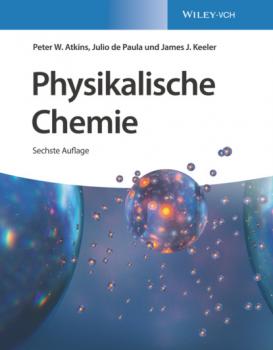Химия
Различные книги в жанре ХимияPhysikalische Chemie
Das unverzichtbare, umfassende Lehrbuch der Physikalischen Chemie!<br> <br> Der «große Atkins» ist und bleibt ein Muss für alle Studierenden, die sich ernsthaft mit der Physikalischen Chemie auseinandersetzen. In unverwechselbarem Stil deckt Peter Atkins mit seinen Koautoren Julio de Paula und James Keeler die gesamte Bandbreite dieses faszinierenden und herausfordernden Fachs ab.<br> <br> In der neuen, sechsten Auflage ist der Inhalt modular aufbereitet, um so das Lernen noch strukturierter und zielgerichteter gestalten zu können. Wie immer beim «Atkins» gehen Anschaulichkeit und mathematische Durchdringung des Stoffes Hand in Hand. Und natürlich kommt der Bezug zu den Anwendungen der Physikalischen Chemie und ihrer Bedeutung für andere Fachgebiete nie zu kurz.<br> <br> * Jeder Abschnitt stellt explizit Motivation, Schlüsselideen und Voraussetzungen heraus<br> * Durchgerechnete Beispiele, Selbsttests und Zusammenfassungen der Schlüsselkonzepte erleichtern Lernen und Wiederholen<br> * Kästen mit Hinweisen zur korrekten Verwendung von Fachsprache und chemischer Konzepte helfen dabei, typische Fehler und Fehlvorstellungen zu vermeiden<br> * Herleitungen von Gleichungen erfolgen in separaten Toolkits, um das Nachschlagen und Nachvollziehen zu erleichtern<br> * Diskussionsfragen, leichte Aufgaben, schwerere Aufgaben, und abschnittsübergreifende Aufgaben in umfangreichen Übungsteilen an den Abschnittsenden<br> * Das Arbeitsbuch ist separat erhältlich und mit dem Lehrbuch im Set<br> <br> Zusatzmaterial für Dozentinnen und Dozenten erhältlich unter www.wiley-vch.de/textbooks<br>
Superatoms
Explore the theory and applications of superatomic clusters and cluster assembled materials Superatoms: Principles, Synthesis and Applications delivers an insightful and exciting exploration of an emerging subfield in cluster science, superatomic clusters and cluster assembled materials. The book presents discussions of the fundamentals of superatom chemistry and their application in catalysis, energy, materials science, and biomedical sciences. Readers will discover the foundational significance of superatoms in science and technology and learn how they can serve as the building blocks of tailored materials, promising to usher in a new era in materials science. The book covers topics as varied as the thermal and thermoelectric properties of cluster-based materials and clusters for CO2 activation and conversion, before concluding with an incisive discussion of trends and directions likely to dominate the subject of superatoms in the coming years. Readers will also benefit from the inclusion of: A thorough introduction to the rational design of superatoms using electron-counting rules Explorations of superhalogens, endohedrally doped superatoms and assemblies, and magnetic superatoms A practical discussion of atomically precise synthesis of chemically modified superatoms A concise treatment of superatoms as the building blocks of 2D materials, as well as superatom-based ferroelectrics and cluster-based materials for energy harvesting and storage Perfect for academic researchers and industrial scientists working in cluster science, energy materials, thermoelectrics, 2D materials, and CO2 conversion, Superatoms: Principles, Synthesis and Applications will also earn a place in the libraries of interested professionals in chemistry, physics, materials science, and nanoscience.
Computational Modeling and Simulation Examples in Bioengineering
A systematic overview of the quickly developing field of bioengineering—with state-of-the-art modeling software! Computational Modeling and Simulation Examples in Bioengineering provides a comprehensive introduction to the emerging field of bioengineering. It provides the theoretical background necessary to simulating pathological conditions in the bones, muscles, cardiovascular tissue, and cancers, as well as lung and vertigo disease. The methodological approaches used for simulations include the finite element, dissipative particle dynamics, and lattice Boltzman. The text includes access to a state-of-the-art software package for simulating the theoretical problems. In this way, the book enhances the reader's learning capabilities in the field of biomedical engineering. The aim of this book is to provide concrete examples of applied modeling in biomedical engineering. Examples in a wide range of areas equip the reader with a foundation of knowledge regarding which problems can be modeled with which numerical methods. With more practical examples and more online software support than any competing text, this book organizes the field of computational bioengineering into an accessible and thorough introduction. Computational Modeling and Simulation Examples in Bioengineering: Includes a state-of-the-art software package enabling readers to engage in hands-on modeling of the examples in the book Provides a background on continuum and discrete modeling, along with equations and derivations for three key numerical methods Considers examples in the modeling of bones, skeletal muscles, cartilage, tissue engineering, blood flow, plaque, and more Explores stent deployment modeling as well as stent design and optimization techniques Generates different examples of fracture fixation with respect to the advantages in medical practice applications Computational Modeling and Simulation Examples in Bioengineering is an excellent textbook for students of bioengineering, as well as a support for basic and clinical research. Medical doctors and other clinical professionals will also benefit from this resource and guide to the latest modeling techniques.
Аналитическая химия и физико-химические методы анализа
Практикум включает качественный анализ неорганических соединений (8 лабораторных работ) и количественный анализ (11 лабораторных работ, в том числе 3 работы по физико-химическим методам анализа). В каждой работе приводится перечень вопросов для теоретической подготовки, а также вопросы и задачи для самостоятельной работы студентов. Для студентов бакалавриата, обучающихся по направлениям подготовки «Технология продукции и организация общественного питания», «Продукты питания из растительного сырья», «Продукты питания животного происхождения», а также для студентов средних специальных учебных заведений и колледжей.
Физико-химические методы анализа
В практикуме, составленном в соответствии с программой по курсу аналитической химии, описаны спектральные, оптические, электрохимические и хроматографические методы анализа. Рассмотрены теоретические основы и возможности физико-химических методов анализа, дано подробное описание лабораторных работ и аппаратуры. Для студентов бакалавриата, обучающихся по направлениям подготовки «Технология продукции и организация общественного питания», «Товароведение» и «Торговое дело» (профиль «Товароведение и экспертиза продовольственных товаров»).
Ядерный микроскоп. Квантовая математика школьникам
Математический микроскоп для изучения атома – это самый перспективный инструмент науки. Оцифровка атома объясняет потепление климата!









